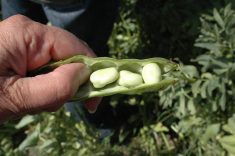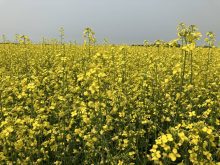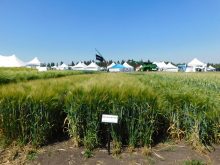China’s bid to double milk production will mean a huge increase in forage imports, and opportunities abound in the Middle East
It’s a good time for forage producers to get into exporting — but there are pitfalls, too, says the chair of the Canadian Forage and Grassland Association’s forage export committee.
“One of the things we’re realizing is that good data is hard to find, especially when you are talking about exports to the U.S.,” said Marc Lavoie, who operates Macay Enterprises in the Peace River area.
“There are a lot of people who are sending product and it’s not being documented properly, so we don’t have very good numbers on what goes to the U.S.”
Read Also

New crop insurer policy enables easier startup for faba beans
Agriculture Financial Services Corporation updated its normals for faba beans, which may open the door for more Canadian producers to feel comfortable growing the pulse crop in the future.
More than 95 per cent of Canadian hay is used domestically, with most of the rest going to the U.S., the biggest customer, Japan, South Korea and Taiwan, Lavoie told attendees at a recent meeting of the Alberta Forage Industry Network.
But China’s imports of Canadian forage are increasing, and the United Arab Emirates and Saudi Arabia are developing markets in the Middle East, he said. Niche European markets, like the racehorse industry, are also looking to import quality Canadian hay.
The horse industry wants high-end timothy, while lower- quality mixed hays are used by feed stores in the U.S. The dairy industry in South Korea and Japan want high-fibre, rather than high-protein, hays, while the Middle East buys alfalfa or mixed hays with high protein for their dairy herds. Alfalfa, mixed hay, timothy hay and straw are attractive forages for the Japanese beef market, while Middle Easterners want pure alfalfa hays for camels, goats and sheep. Many global markets are also looking for small quantities of hay for rabbits raised as pets or for food.
It’s also important to keep an eye on demographics, said Lavoie, noting the population of Japan peaked last year and is now edging downward.
“We know that eventually their usage will decline, therefore their forage imports will decline over the next 10 to 15 years,” he said.
Eight years ago, half of Japan’s imports of forage came from Canada, but last year that had shrunk to six or seven per cent because of hay shortages here, the rising Canadian dollar and increased freight costs, as well as increased competition.
However, Canada’s ample supplies of fresh water is an advantage, said Lavoie.
“Our freight costs are still higher than the U.S. but we’re still able to be competitive in certain areas. In some countries, we’re not,” Lavoie said.
Shipping to the Middle East is difficult, especially for producers from Western Canada, and access to containers is also an issue for Saskatchewan and Manitoba growers. Those wanting to export to that region also have to understand what quality is wanted and that Middle East importers want large bales, he said.
“These kinds of things are really important, if you’re looking at doing some export,” Lavoie said.
The Canadian Forage and Grassland Association has undertaken several fact-finding missions. On a trip to China last year, they learned about the country’s plan to double milk production.
“You don’t double your milk production without using double the forage,” noted Lavoie. “China is not able to grow double the forage, so where does it come from?”
On a trip to the Middle East three years ago, they looked at how the United Arab Emirates will adapt to a decision to stop using water to irrigate their forages. UAE forage imports hit 1.5 million tonnes last year and are expected to reach 1.8 million tonnes this year.
“Saudi Arabia has seven times the population of the United Arab Emirates,” said Lavoie. “If they are looking at importing all their forages, that leaves you with a big number that needs to be filled.”
India is also starting to import more forages.
“The poorer countries are starting to eat more like the richer countries, which means they are eating more milk and meat, which means you need more forages,” he said.















